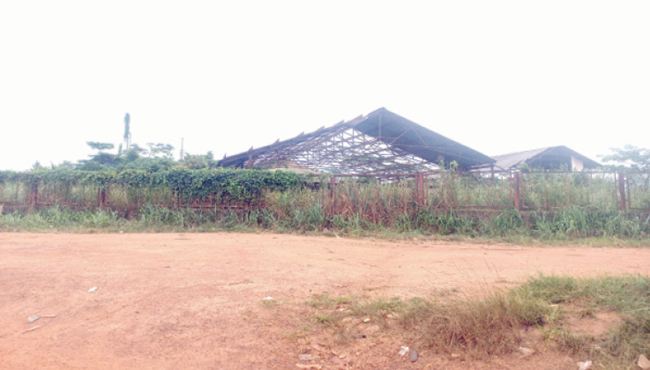Omo Forest Reserve is the only forest reserve in Southwest Nigeria that has been recognised internationally as a sanctuary for biodiversity. PAUL OMOROGBE, who visited the forest, reports how this sanctuary is threatened by uncontrolled farming and logging activities.
In 2018, there was a sad case of an individual in village called Baoku in Ijebu East Local Government Area of Ogun State who was trampled to death by an elephant. Elephants are reclusive animals. In Southern Nigeria, they cannot be found except deep inside forests. The incident that led to the casualty was due to an incursion deep inside Omo Forest Reserve where elephants make their home. The incident was symptomatic of the disturbances that have occurred in Omo Forest Reserve, a place that is meant to be a sanctuary for biodiversity in the Southwest region and the country at large. Economic forces and uncontrolled exploitation have taken their toll on plant and animal resources in the reserve.

History of Omo Forest Reserve
Omo Forest Reserve is the first forest reserve in Nigeria to be considered a biosphere reserve by the United Nations Educational, Scientific, and Cultural Organisation (UNESCO) due to its pristine nature in 1977. A biosphere reserve is a protected natural area that is part of a global network established by UNESCO.
According to history contained in “Biodiversity Inventory of Omo Biosphere Reserve, Nigeria,” a country report on Biosphere Reserves for Biodiversity Conservation and Sustainable Development in Africa (BRAAF), the Omo Forest Reserve was legally constituted as a forest reserve by Order No. 10 of 1925 and the Order was amended in 1952.
Previously, the forest was practically unexplored by then. The forest was ceded to Government for reservation on October 8, 1918. The agreement was made between the District Officer, Ijebu Ode on behalf of the Government and the Awujale of Ijebu Ode on behalf of the Ijebu Native Administration. The area of Omo Forest Reserve, which is 1305.5km2 is divided into Areas J1 – J3 (519.3km2), Area J4 (565.8km2), Area J6 (220.4km2) and enclaves (65km2).

A working plan was drawn for the management of the reserve in September 1957. Rotation period was set at 100 years and the working circle covered 1,167 square kilometres covering the whole of Omo Forest Reserve and Osun Forest Reserve. 1,088 square kilometres were to be managed under the Uniform Shelterwood Compartment System.
Within the forest reserve, certain rights were granted to the local people such as the right to hunt, fish, tap rubber, collect snails, tortoises, fruits and other minor forest products. The communal owners of the land were also granted 17 percent of the royalties on timber harvested in the reserve. Farmlands were also allocated to the various communities.
On June 2, 1950, an exploitation agreement for Concession Area and exploitation of timber or firewood from the Concession Area was signed between the Native Authority of Ijebu Province and Omo Sawmills of Nigeria Limited.
The Federal Department of Forest Research, now Forestry Research Institute of Nigeria (FRIN), Ibadan, established experimental plots at Oloji in May 1952 to assess and monitor long term changes in rainforest at Omo Forest Reserve. Also, in 1975, the Federal Department of Forestry, under the High Forest Monitoring Plots Project, established 26 one-hectare permanent sample plots in Omo Forest Reserve (10 in Aberu sector and 16 in Abeku sector).
The core, which covers an area of 8km2 was demarcated in 1949 and managed as a Strict Nature Reserve (SNR). This core or SNR is located within Area J4. Area J4 is a thriving community of people today.
The establishment of Omo Sawmill Industry and the introduction of the forest plantation projects rapidly expanded the human population within and around the reserve.
Why human-wildlife conflicts occur
Human-wildlife conflicts, such as the Baoku episode in 2018, generally occur when human and wildlife populations overlap and are forced into closer contact. Some of the factors responsible for this occurrence include habitat loss. In a rapidly growing population, urban areas expand and natural habitats are destroyed; thereby wildlife are pushed out of their natural habitats. Another reason is resource competition whereby humans and wildlife compete for resources. There is also the case of agricultural expansion, whereby cultivated land expands into previous wildlife habitats.
Preserving Omo Forest Reserve
Many rural communities in Nigeria rely heavily on their natural environment for their livelihoods and socioeconomic well-being. Local populations in and surrounding forest ecosystems rely heavily on biodiversity and natural resources for their survival. Omo Forest Reserve is not exempt. Intense dependence on these natural resources is telling on the environment and increasing the instances of human-wildlife conflict. Logging and agricultural activities take place legally in and around the reserve. The challenge lies with loggers and farmers who go beyond the allotted space for such activities.
When Nigerian Tribune visited Area J4, Obafemi Shittu, chairman of Ijebu Ode Sawmillers and Timber Contractors Association, noted that the forest and consequently licensed loggers had seen better days.
He said, “When the forest was alive, you would enjoy it. This sawmill was working very well at the time. The sawmill has been existing for over 40 years. But now, it is down. On our part, illegal migrants who have entered into this forest reserve are turning it into a cocoa plantation.
“In those days we had a lot of elephants in this reserve and we admired them. Then we had J1, J2, J3, J4 and J6. But now, everything is down. There is nothing in J3 anymore. We used to work in J3. We saw all types of animals including elephants, bulls and antelopes. Back then at times, when we were returning at night, we would encounter bulls lying on the road. We would have to wait for them to move away before we could pass. But that has changed.
“If you walk through this forest, you will find more cocoa trees and less forest trees. We have complained about this to the state and federal government, but it seems no one is listening to us. The government has been trying. There was a time the government came and drove them away, but they have returned in full force.”
Shittu recalled that a variety of tree species in Omo were available for felling once upon a time.
“We had up to 10 species in the forest then including cedar, opepe, mahogany, masonia, teak, pines, black afra and Melania; but you can’t find any of them today. Then, in those days, you had to mark the size of tree to cut. It should not be less than six feet round in girth. But we don’t see such anymore.”
He alleged that the disappearance of such tree species was due to the incursion of farmers into the forest to destroy trees to make way for farming. “This is what is giving us, timber contractors in Ogun State, sleepless nights. We have tried to drive them away but they keep coming in their numbers even from outside Nigeria.”
Shittu said that there was need for government authorities to look into this and halt further incursion, especially into the area of the forest reserve which locals call Queen Elizabeth farm, whose proper name is “Queen’s Plot.” This is the core area or SNR mentioned earlier.
“The government should listen to us and protect this forest. It’s not for us. I’m getting old. But what of the next generation?” he said. “In the Southwest there is no other forest reserve like this. I don’t know if there are other reserves in other parts of Nigeria.”
Tajudeen Sefiu, an aged man living in Area J4, has spent a greater part of his life as a hunter. Sefiu narrated how deep forays into the forest for farming and hunting led to habitat loss for wildlife. He said he remembered the times when elephants, gorillas, leopards and buffaloes were common in the area. “We used to have a lot of those animals around. For example, we could easily go looking for elephant excreta which we uses for certain medicines. Now it is very scarce. What happened is that when the forest was degraded to plant other trees and hunting activities, those animals began to disappear.”
He said the concerned government authorities should ensure strict monitoring of the core area of the forest to preserve the remaining wildlife therein.
Bisiriyu Safi, Baale of Abakurudu in Area J4, was born where he lives today. He corroborated the narrative that wildlife was abundant years ago. “We used to have a lot of animals here. However, the noise of chainsaws cutting down trees has driven them farther into the forest,” Safi said.
“This place used to be their habitat. Now, they are a rare sight because of the farming and logging in the forest,” he added.
Understanding UNESCO’s involvement
Omo Forest Reserve is a unique forest reserve in all of Southwest Nigeria, as the only forest that has been recognised as a biosphere reserve by UNESCO.
Dr Tayo Oyelowo, Omo Biosphere Reserve Project Focal Point at FRIN, told Nigerian Tribune more about the significance of this reserve and the incursions it has witnessed in recent time.
He said, “For a conservation area to be recognised by UNESCO it must have a core zone, a buffer zone and a transition zone. There are other requirements but this is the major one. The core zone is the area meant for research purposes. The area we call buffer surrounds the core, and the transition area surrounds the buffer.
“Their (UNESCO’s) conservation strategy is not to isolate communities. The resources are for community’s use. The communities are original owners.”
He, however, added: “By this zonation, nobody should enter the core. It is strictly meant for research; it is to be protected for ecosystem services and others.”
Explaining further, Dr Oyelowo said, “The buffer zone is an interface that covers the core. The remaining areas are free for any development for farming, schools, or anything. This is the transition area, but still under regulation.
“When these zones were recognised at Omo Forest Reserve, UNESCO enlisted the reserve in 1977 as part of the forests they can implement projects. UNESCO will not go into any conservation area without that.”
With the agreement with UNESCO, the body began projects there. Omo Forest Reserve became known as Omo Biosphere Reserve internationally and among researchers.
Management plan
“For every forest reserve, it is meant for utilisation but in a sustainable manner. Once it is not being managed in a way to sustain biodiversity, it is means they have derailed from the objective of conservation. Omo transition area is very large. It is divided into compartments,” Dr Oyelowo noted.
He said that there is a management plan for sustainable use of the forest. He explained that such plan would ensure that forest compartments have up to 50 years to regenerate. “Imagine a forest that’s left to regenerate for 50 years. Nobody will know that it was touched in the first place. That is the beauty of biological diversity; that is the beauty of regeneration.”
But the situation on ground appears that such management plan is not being followed by the authorities concerned.
“If you must cut trees as a logger, you must be a certified one. You must register with the government. You will be given a certain area to log. Are these loggers being monitored whether they have exceeded the boundary?
“Even if you are to log, there is a certain girth of trees that you can cut. Are they following this policy?
“If you discover an area has been degraded what are your efforts to regenerate that place?” Dr Oyelowo added.
Read Also: JOHESU suspends warning strike
Farmers, loggers at loggerheads
The farmers and loggers are not particularly on friendly terms, Nigerian Tribune gathered. Farmers have been alleged to be planting cocoa in the forests. “They believe that forest lands are more fertile and suitable for the cultivation of cocoa. Farmers destroy forest trees to give way for cocoa plantations within the forests,” said a source who preferred anonymity.
“What do some farmers do? They poison trees. Cocoa is a shade-loving cash crop at its early stage. They plant it under the forest cover. So it is difficult to detect when farmers have begun planting cocoa in a particular section of the forest. You will see a luxuriant forest from outside, but will not see that they have planted cocoa inside. By the time you move 50 metres into the forest, you will find cocoa. And after a while, the trees die off. They have that strategy and it affects the loggers. The loggers on their part when they come to cut trees will not mind the cocoa trees. If you do not understand the ‘politics’ between them, you will be shifting the blame. The farmers know where the illegal loggers are. When the illegal loggers have come to harvest, the cocoa farmers will take over.
“The illegal loggers can be called bandits. They go around with arms, and nobody dares to confront them. They have backing of powerful people.”
Government’s response
The Ogun State Government deserves commendation for maintaining the only UNESCO standard forest reserve in all of Southwest Nigeria. However, recent incursions into the core area of Omo Forest Reserve and subsequent disturbance of the biodiversity therein requires urgent response from the state government that has responsibility for the reserve according to law.
Speaking to the issue, the Dr Samuel Oyeleye, Permanent Secretary, Ogun State Ministry of Environment, told Nigerian Tribune that the state government is aware of the pressure that economic factors place on communities to exploit these resources for farming, hunting and logging. However, according to him, the state government is collaborating with agencies within and outside the state to ensure that the biodiversity of Omo Forest Reserve remains intact.







